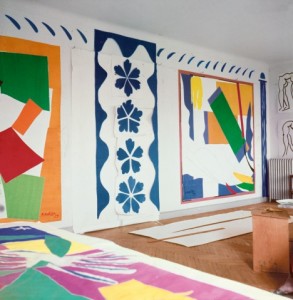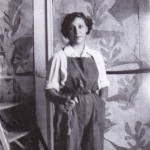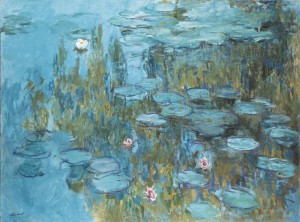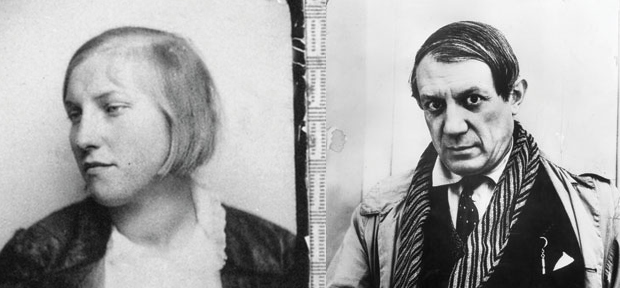 As the sun set in Paris, on January 8, 1927, Pablo Picasso was walking past a fashionable department store when his eyes fell upon a young shopper. Immediately infatuated, the artist (then unhappily married and in his mid-forties) took Marie-Thérèse Walter by the arm and said, “I’m Picasso! You and I are going to do great things together!” She was confused by the man and unaware of who he might be. Picasso introduced himself by dragging her into a bookshop and showing her a book filled with reproductions of his paintings. Thus began a passionate affair and an enormously productive period for Picasso. Continue reading
As the sun set in Paris, on January 8, 1927, Pablo Picasso was walking past a fashionable department store when his eyes fell upon a young shopper. Immediately infatuated, the artist (then unhappily married and in his mid-forties) took Marie-Thérèse Walter by the arm and said, “I’m Picasso! You and I are going to do great things together!” She was confused by the man and unaware of who he might be. Picasso introduced himself by dragging her into a bookshop and showing her a book filled with reproductions of his paintings. Thus began a passionate affair and an enormously productive period for Picasso. Continue reading
Tag Archives: artist studio
Cold? Rembrandt’s studio was probably colder.
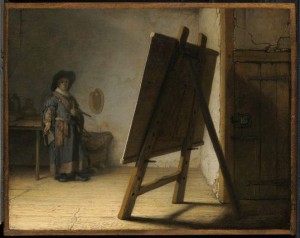 In Boston’s Museum of Fine Arts, there is a small Rembrandt of an artist at work in his studio that symbolizes the difficulty of making art. The dark, large canvas on the easel seems huge and forbidding. With thick, spread legs, it dominates the picture and looms over the artist, who appears to have backed away from it, perhaps in fear.
In Boston’s Museum of Fine Arts, there is a small Rembrandt of an artist at work in his studio that symbolizes the difficulty of making art. The dark, large canvas on the easel seems huge and forbidding. With thick, spread legs, it dominates the picture and looms over the artist, who appears to have backed away from it, perhaps in fear.
However, this painting has taken on a whole new meaning for me because of this frigid winter in the Northern U.S. While I never gave it a thought in the past, the artist (who resembles Rembrandt) is clearly unnaturally bundled up in heavy clothing even though he is inside.
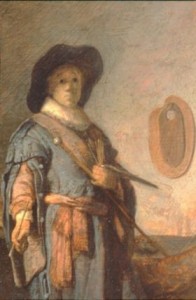 What is going on? Is the studio cold because the artist lacks the money to heat it? Or is it something else?
What is going on? Is the studio cold because the artist lacks the money to heat it? Or is it something else?
Painted around 1628, when Rembrandt was in his early twenties, the studio’s bareness could simply depict a struggling, young artist and the tools of his trade. We can see his palettes hanging behind him, brushes and a maul stick in his hands. To the right, is a large grinding stone where he makes his paints. To the left, is a table probably with jugs of oil and solvent.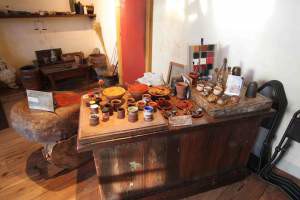
If you visit Rembrandt’s studio in Amsterdam – Rembrandthuis — you can see many of the same things and even witness a demonstration of how he ground his dry pigments into a paste by mixing them with oil. This stone looks nearly identical to the one there.

Hendrick Avercamp, A Winter Scene with Skaters near a Castle, c. 1608–1609, oil on panel, The National Gallery, London
But his clothing is a clue to something else. In 1628, Europe was in the midst of what is known as “the Little Ice Age.” By the time of the painting, global cooling had been underway for more than a century. In winter, the canals of Holland would freeze over and not thaw again until late in the spring. Growing glaciers had crushed small villages in Switzerland. The importance of the North American trade in beaver pelts was a direct result of climate change. Rembrandt’s artist is probably wearing a felt hat quite popular in this era and made from those pelts. [The phrase “mad as a hatter” comes from the dangerous effects of the chemicals used to treat beaver fur.]
At the time of this painting, Amsterdam was rapidly growing and had become the most important port and economic center of Europe. Homes were heated by burning peat harvested from bogs. Because of the rapid growth of Holland’s population, however, the peat bogs had nearly been exhausted and peat’s cost skyrocketed.
The combination of expensive fuel and the peaking of The Little Ice Age made for a poor time for a young artist to start his career. No wonder he is bundled up and fearful. It was really a cold world out there. I hope he sold the painting.
See and hear Matisse — drawing with charcoal and scissors
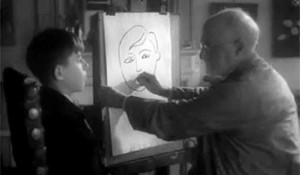 The following two short videos provide brief glimpses of Henri Matisse at work in his studio. In the first from 1946, he draws a portrait of his grandson, Gerard, with charcoal. In the second, he was filmed near the end of his life “drawing with scissors,” which is how he described his method of working with hand-colored papers.
The following two short videos provide brief glimpses of Henri Matisse at work in his studio. In the first from 1946, he draws a portrait of his grandson, Gerard, with charcoal. In the second, he was filmed near the end of his life “drawing with scissors,” which is how he described his method of working with hand-colored papers.
Besides the rare opportunity to see Matisse at work, we can also hear his voice in the first video. He is explaining how he thinks about drawing. His comments translated into English are:
“Me, I believe that painting and drawing are the same thing. Drawing is a painting done in a simpler, limited way. On a white surface, a sheet of paper, with a pen and some ink, one creates a certain contrast with volumes; one can change the quality of the paper given supple surfaces, light surfaces, hard surfaces without always adding shadow or light. For me, drawing is a painting with limited means.”
- Jaqueline Duhême standing in front of designs for the Tree of Life stained-glass window for the Chapel of the Rosary, Vence.
- Matisse at the Hôtel Régina, Nice, c. 1949 Photographer: Lydia Delectorskaya© Succession Henri Matisse
- Matisse working on a cut-out, c. 1949.
Jacqueline Duhême, one of Matisse’s studio assistants in the late 1940s, describes how he made his cut-outs here.
See Monet Painting Waterlilies
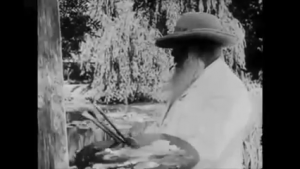 In our continuing series of peeks into artist studios — a unique item. A rare 2 1/2 minute film that shows Monet painting his waterlily pond in Giverny in 1914. And his little dog, too.
In our continuing series of peeks into artist studios — a unique item. A rare 2 1/2 minute film that shows Monet painting his waterlily pond in Giverny in 1914. And his little dog, too.
[Thanks to Vincent Pidone for the tip.]
For those who like to peek into artist’s studios
I’ve discovered a wonderful blog, atelierlog. Since 2005, the Dutch artist, Harke Kazemier, has been collecting and posting looks into artist studios, from Rembrandt to Lucian Freud. While some of the text is in Dutch, the main content is the pictures and videos. If you are like me, you’ll find the more than a thousand entries fascinating. atelierlog is a rich resource that I highly recommend.

